Extended Family
Significate dates and/or documents
By Sister Mary Luke Baldwin, SSND
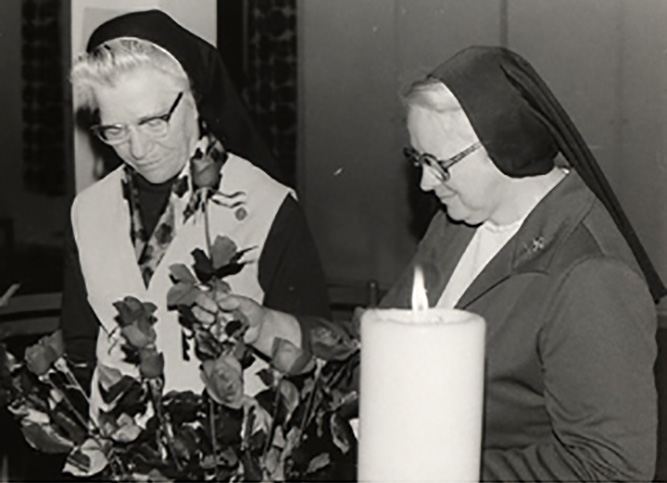
Mother Georgianne Segner, SSND (left) and Sister Mary Luke Baldwin, SSND (right)
Mother Georgianne Segner, SSND, General Superior (1968-1977), shares concern for her Sisters living behind the Iron Curtain. It was written at the time of Mother Georgianne’s death in 2000.
During her nine years as General Superior of the School Sisters of Notre Dame, Mother M. Georgianne Segner showed special concern for the hundreds of School Sisters of Notre Dame, who were still living “Behind the Iron Curtain.” Shortly after assuming office in 1968, she began to visit them wherever it was possible, both to ascertain their needs and situation and to provide encouragement. When she could not obtain visas, she arranged for her general councilors to visit these sisters whenever possible.
Mother Georgianne visited the Sisters in Poland, East Germany, Czechoslovakia, Hungary, Yugoslavia, and Romania, often at personal risk and subject to surveillance even after obtaining visas, sometimes with difficulty and delay. In 1971 she was able to visit Romania as an American tourist—the first time a General Superior had been there in 22 years. At the time there were more than 200 sisters, unable to live publicly as religious, but remaining faithful and in touch with the larger community.
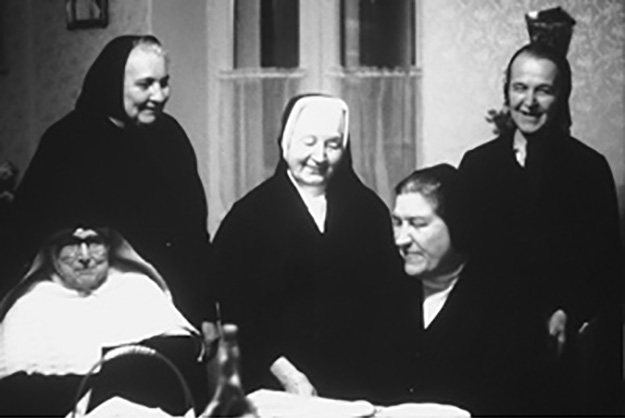
Sister Amabilis (seated at right) visits with Sisters living under communism.
Notice the different habits worn under Communism, as well as street clothes.
Each group in Eastern Europe had its own difficulties: some had been officially disbanded, but remained united in secret through their own elected or appointed leaders; others had had their schools and convents confiscated and were literally displaced. These sisters were limited in their ministry, sometimes assigned by the government to care for developmentally disabled children and women, for abandoned infants until the age of two, sometimes for the frail elderly, or for other women religious in “concentration convents.” In some, they were disbanded.
Mother Georgianne did everything possible to have the delegates from these countries attend the international meetings of the congregation in Rome and arranged to provide funds for their needs. She was deeply moved by the Unity in Diversity and text of these sisters sharing faith during their very difficult times. She spent many hours simply listening to their stories and praying with them. Whenever possible she provided direct assistance.
In addition to her visits with sisters in Eastern Europe, Mother Georgianne's Circular Letters indicate her concern, the time of visits, and her motivation and hopes.
Circular, March 13, 1969:
“While in general there have been very positive, hopeful, and enthusiastic responses to the Interim Documents, there have also been reactions of fear, tension, and reluctance. This is natural, and such reactions come to every human being from time to time. Yet we must also pray much for His Spirit to calm and guide us, knowing that the Will of the Father is manifested to us in so many aspects of the people around us and the world in which He moves so freely…”
“Our Interim Documents are based on a premise that ‘Unity can exist through diversity.’ Our ability to achieve unity in diversity will determine the future growth of our community…our SSND Congregation.”
June, July 1969
Visited the Yugoslavian Province and presided at the Provincial Chapter of Elections in June.
She was able to visit the Czechoslovakian Province in July 1969, accompanied by Sister Enrica. She was not able to visit Hungary or Rumania at that time, but Sister Augusta, being from Yugoslavia, readily obtained visas.
June 1970
Mother Georgianne and Sister Enrica visited Poland. Mother Georgianne and Sister Aquina visited West Berlin
July 1970
Mother Georgianne and Sister Aquina visited East Germany (East Berlin) Mother Georgianne and Sister Augusta, visited Hungary.
”We were really happy to see our Sisters in Eastern Europe and to live in community with them. They extend good wishes for success in your varied apostolates. Variety of service is nothing new for them. In these provinces, one sees readily the principle of ‘unity in diversity’ in practice. Very special greetings from Mother Margit Desi, who, although her speech is still impaired, and her arm and leg lame, her beautiful resignation portrays a presence of God which cannot be forgotten.”
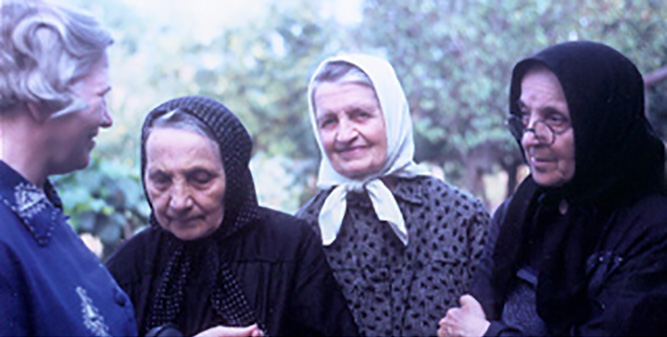
Mother Georgianne (at left) visiting with Sisters in Romania.
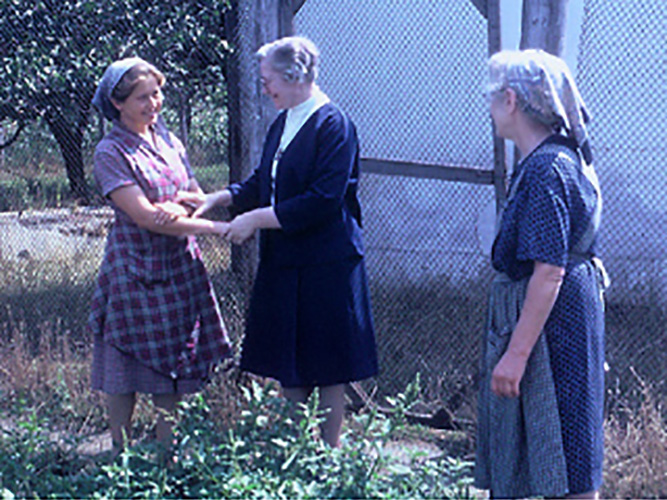
Mother Georgianne greeting Sisters at the chicken farm in Romania.
October, November 1970, Circular #17/70:
“…during these months I have personally met hundreds of you, and spoken to thousands of you as I traveled through the United States and England with Sister Mary Luke introducing our own world community to you through colored slides and commentary. The presentation created a great sense of identity, and a deeper love and concern for all of the great women of our international congregation who share our common heritage and whose goals are the upbuilding of the Kingdom of God in such a variety of communities and apostolates, and in such various political and educational situations around the world…”
June-July, 1971
“Although Sister Aquina and I did not receive a visa to East Germany, we were able to be present for the Berlin Regional Election, June 16, 1971 .” [Not quite clear how this took place. Mary Luke’s note]
August 1-10, 1971
Mother Georgianne, Sisters Mary Luke, Henriette, and Mary Roman, traveling on tourist visas, were able to enter Romania and meet many of the Sisters there. Although they were “disbanded,” the provincial, Mother Domitia, was in touch with them and had a record of their health, residence, and so on. In the course of four days, we were able to meet more than 100 sisters in the Temesvar area.
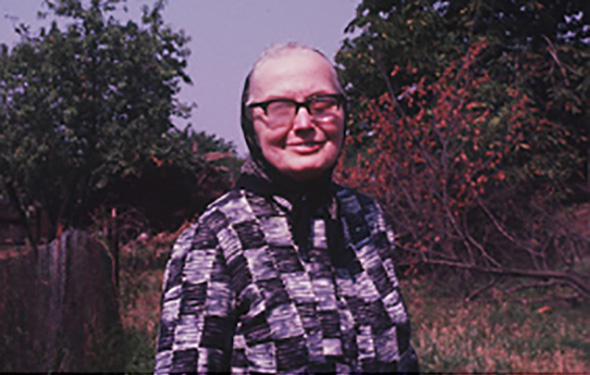
Mother Gerta smiles in spite of difficulties faced under communism.
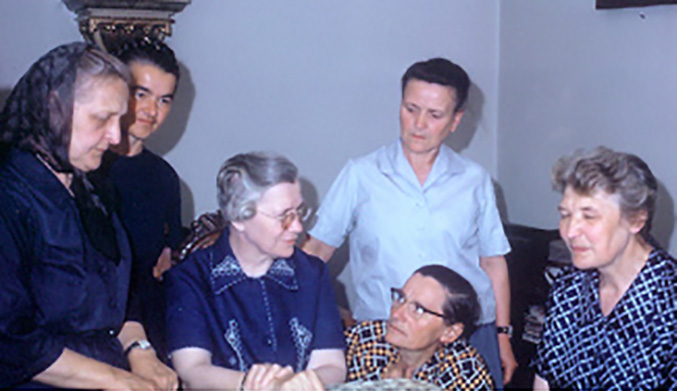
Romanian Sisters delighting in Mother Georgianne's (seated in center) presence.
This was the first time a superior general had been able to visit there in 22 years. It was a brief, but a deeply moving experience for all. Among the most powerful events was the final vow ceremony held in the small “office” of the provincial in the church sacristy—Sister had waited 22 years for this commitment. There was also a kind of provincial assembly at the chicken farm, settling the leadership of the province.
Circular Letter October 17, 1971 (#24/71)
“We who visited Romania shared a deep faith experience during the visit with our Sisters there. Whenever and wherever possible we, in turn, have tried to share this experience with others. Our Romanian Sisters themselves discovered anew that they are part of a large international community and they are thought of by all of us with real affection and concern. More and more of our Sisters are growing in a new understanding of what distinguishes us as “School Sisters."
Circular Letter July 8, 1972 (#33/72)
“Since the General Chapter of 1968, the General Councilors and I have made consistent efforts to visit our 200 Sisters in East Germany. Finally, in June 1972 Sister Aquina succeeded in receiving one. (a visa) Since this is her own native territory we rejoice with her. We are also happy for the Sisters in the region of Berlin, who have waited so long for a visit to each convent by someone from the Generalate. May Sister Aquina’s very personal love for our Sisters there, and her visit with them help to strengthen them and unite all of us in one great bond of unity.”
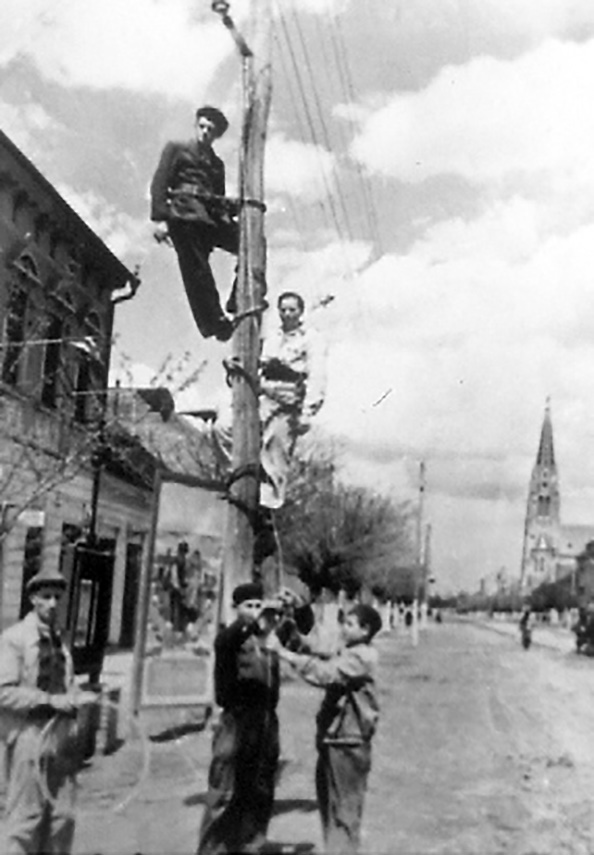
School Sister of Notre Dame (second from top) and coworkers repairing telephone lines in Romania.
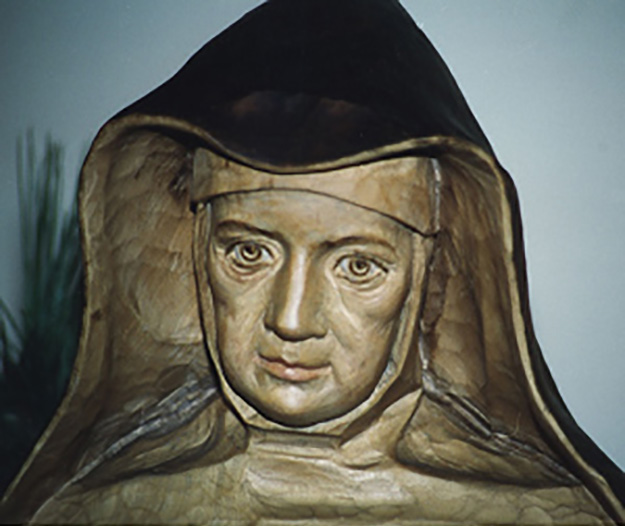
Statue of mother Theresa was a gift from the Polish province to the Sisters of Berlin.
October 23, 1972 Report to General Chapter
“…the rich heritage and faith dimension which is ours in belonging to a community of persons among whom there are hundreds, thousands of Sisters who have known the sufferings and anguish of war, persecution, suppression, oppression, deprivation of their native culture, their homes and loved ones. Sisters are becoming aware in a new way of what the life of a true Christian means and what radical discipleship implies. “In certain situations, such as in Romania, we have seen unusual ways in which Sisters have been living and realizing meaningful community. Although our Sisters are completely secularized by order of the government and many are living alone, the center of their life is truly Christ in the Eucharist, Christ in each Sister, in each person. Even when forced to live alone, the effort to maintain a vibrant Community as a support to their vowed life is an example to all of us."
July 1972, Talk on International Heritage
“Following in the footsteps of Mother Theresa, all the members of the General Council and I have traveled widely and extensively. We have visited every province and region, including all the provinces behind the Iron Curtain where perhaps we today can derive our greatest inspiration to live a life of total commitment in total poverty. It has been our purpose to help our Sisters in all lands to become better known to one another and to understand and appreciate each other’s cultures, which enrich our personal lives and our work. We have tried to revive the knowledge of and interest in the charism of our Foundress in order to be more relevant women of the Church today. Thus we hope to enable all the Sisters to acquire a greater appreciation of their heritage—a heritage which has been enriched by women of many cultures united in diversity, possessing deep faith, and ready to stand with Mary, Mother of the Church and of our congregation welcoming her gentle challenge: “DO WHATEVER HE TELLS YOU.”